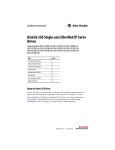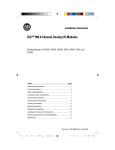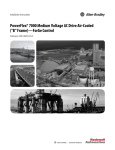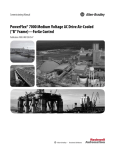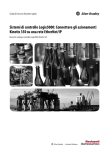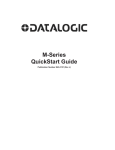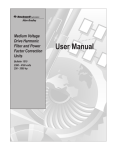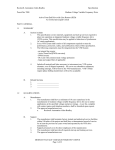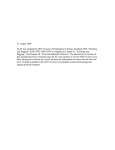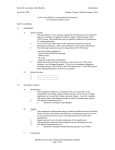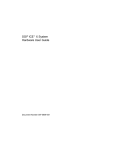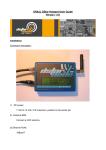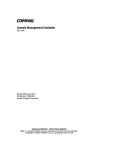Download 7000-IN008_-EN-P - Rockwell Automation
Transcript
Installation Instructions PowerFlex® 7000 Medium Voltage AC Drive Transportation & Handling Procedures Publication 7000-IN008C-EN-P Important User Information Read this document and the documents listed in the Additional Resources section about installation, configuration, and operation of this equipment before you install, configure, operate, or maintain this product. Users are required to familiarize themselves with installation and wiring instructions in addition to requirements of all applicable codes, laws, and standards. Activities including installation, adjustments, putting into service, use, assembly, disassembly, and maintenance are required to be carried out by suitably trained personnel in accordance with applicable code of practice. If this equipment is used in a manner not specified by the manufacturer, the protection provided by the equipment may be impaired. In no event will Rockwell Automation, Inc. be responsible or liable for indirect or consequential damages resulting from the use or application of this equipment. The examples and diagrams in this manual are included solely for illustrative purposes. Because of the many variables and requirements associated with any particular installation, Rockwell Automation, Inc. cannot assume responsibility or liability for actual use based on the examples and diagrams. No patent liability is assumed by Rockwell Automation, Inc. with respect to use of information, circuits, equipment, or software described in this manual. Reproduction of the contents of this manual, in whole or in part, without written permission of Rockwell Automation, Inc., is prohibited. Throughout this manual, when necessary, we use notes to make you aware of safety considerations. WARNING: Identifies information about practices or circumstances that can cause an explosion in a hazardous environment, which may lead to personal injury or death, property damage, or economic loss. ATTENTION: Identifies information about practices or circumstances that can lead to personal injury or death, property damage, or economic loss. Attentions help you identify a hazard, avoid a hazard, and recognize the consequence. IMPORTANT Identifies information that is critical for successful application and understanding of the product. Labels may also be on or inside the equipment to provide specific precautions. SHOCK HAZARD: Labels may be on or inside the equipment, for example, a drive or motor, to alert people that dangerous voltage may be present. BURN HAZARD: Labels may be on or inside the equipment, for example, a drive or motor, to alert people that surfaces may reach dangerous temperatures. ARC FLASH HAZARD: Labels may be on or inside the equipment, for example, a motor control center, to alert people to potential Arc Flash. Arc Flash will cause severe injury or death. Wear proper Personal Protective Equipment (PPE). Follow ALL Regulatory requirements for safe work practices and for Personal Protective Equipment (PPE). Allen-Bradley, Rockwell Software, Rockwell Automation, and TechConnect are trademarks of Rockwell Automation, Inc. Trademarks not belonging to Rockwell Automation are property of their respective companies. Summary of Changes New and Updated Information This table contains the changes made to this revision. Topic Page General style changes according to Rockwell Automation standards throughout Updated Inside Front Cover 2 Updated Commissioning Support information 8 Updated Shock Indicator information 11 Rockwell Automation Publication 7000-IN008C-EN-P - April 2013 3 Summary of Changes Notes: 4 Rockwell Automation Publication 7000-IN008C-EN-P - April 2013 Table of Contents Chapter 1 Important User Information Who Should Use This Manual . . . . . . . . . . . . . . . . . . . . . . . . . . . . . . . . . . . . . . 7 What Is Not in this Manual. . . . . . . . . . . . . . . . . . . . . . . . . . . . . . . . . . . . . . . . . 7 General Precautions . . . . . . . . . . . . . . . . . . . . . . . . . . . . . . . . . . . . . . . . . . . . . . . . 8 Commissioning Support. . . . . . . . . . . . . . . . . . . . . . . . . . . . . . . . . . . . . . . . . . . . 8 Chapter 2 Transportation and Handling Procedures General Handling Information. . . . . . . . . . . . . . . . . . . . . . . . . . . . . . . . . . . . . . 9 Shipping Details . . . . . . . . . . . . . . . . . . . . . . . . . . . . . . . . . . . . . . . . . . . . . . . . . 10 Receiving the Drive . . . . . . . . . . . . . . . . . . . . . . . . . . . . . . . . . . . . . . . . . . . . . . 11 Export Crate. . . . . . . . . . . . . . . . . . . . . . . . . . . . . . . . . . . . . . . . . . . . . . . . . . . . . 14 Accessories . . . . . . . . . . . . . . . . . . . . . . . . . . . . . . . . . . . . . . . . . . . . . . . . . . . . . . 16 Storage . . . . . . . . . . . . . . . . . . . . . . . . . . . . . . . . . . . . . . . . . . . . . . . . . . . . . . . . . . 16 Planning . . . . . . . . . . . . . . . . . . . . . . . . . . . . . . . . . . . . . . . . . . . . . . . . . . . . . . . . 17 Leveling . . . . . . . . . . . . . . . . . . . . . . . . . . . . . . . . . . . . . . . . . . . . . . . . . . . . . 17 Rigging Contractor. . . . . . . . . . . . . . . . . . . . . . . . . . . . . . . . . . . . . . . . . . . . . . . 18 Overhead Lifting. . . . . . . . . . . . . . . . . . . . . . . . . . . . . . . . . . . . . . . . . . . . . . . . . 18 Rod or Pipe Rollers. . . . . . . . . . . . . . . . . . . . . . . . . . . . . . . . . . . . . . . . . . . . . . . 21 Fork Lift Trucks . . . . . . . . . . . . . . . . . . . . . . . . . . . . . . . . . . . . . . . . . . . . . . . . . 22 Removing Wooden Skids . . . . . . . . . . . . . . . . . . . . . . . . . . . . . . . . . . . . . . . . . 23 Removing Lifting Angles . . . . . . . . . . . . . . . . . . . . . . . . . . . . . . . . . . . . . . . . . 23 Items Shipped Loose . . . . . . . . . . . . . . . . . . . . . . . . . . . . . . . . . . . . . . . . . . . . . 24 Further Instructions. . . . . . . . . . . . . . . . . . . . . . . . . . . . . . . . . . . . . . . . . . . . . . 24 Rockwell Automation Publication 7000-IN008C-EN-P - April 2013 5 Table of Contents Notes: 6 Rockwell Automation Publication 7000-IN008C-EN-P - April 2013 Chapter 1 Important User Information This document provides procedural information for physically installing the PowerFlex 7000 medium voltage drives. These procedures include removing the drive components from the truck and transporting the drive to the installation site within your operation. Who Should Use This Manual This manual is intended for use by plant operations personnel familiar with moving and siting heavy equipment. Specific experience with medium voltage and solid-state variable speed drive equipment is NOT required for this part of the installation process, but will be mandatory for subsequent connection processes. What Is Not in this Manual This manual provides information specific to physically unloading and situating a PowerFlex 7000 drive. It does not include project-specific, nor drive-specific, topics such as: • Dimensional and electrical drawings generated for each customer’s order. • Spare parts lists compiled for each customer’s order. • Drive-specific technical specifications. Please refer to the following documents for additional product detail or instruction relating to PowerFlex 7000 drives: • Drive-specific Technical Specifications • Installation Guide: detailed installation and pre-commissioning information, including an overview of the drive interface and initial parameter configuration. • Commissioning Guide required procedures and checklists for Rockwell Automation commissioning technicians. • User Manual: instructions for daily and recurring drive usage or maintenance tasks • Technical Data: additional troubleshooting, parameters, and specification information for MV variable frequency drives. Rockwell Automation provides the site- and installation-specific electrical and design information to the customer during the order process cycle. Rockwell Automation Publication 7000-IN008C-EN-P - April 2013 7 Chapter 1 PowerFlex 7000 Transportation & Handling Manual If you have multiple drive types or power ranges, ensure you have the correct documentation for each specific PowerFlex 7000 product: • “A” Frame for lower power air-cooled configurations (up to approximately 1250 hp/933 kW) • “B” Frame for higher-power, air-cooled configurations • “C” Frame for all liquid-cooled configurations General Precautions ATTENTION: This drive contains ESD (Electrostatic Discharge) sensitive parts and assemblies. Static control precautions are required when installing, testing, servicing or repairing this assembly. Component damage may result if ESD control procedures are not followed. If you are not familiar with static control procedures, reference Allen-Bradley publication 8000-4.5.2, “Guarding Against Electrostatic Damage” or any other applicable ESD protection handbook. ATTENTION: An incorrectly applied or installed drive can result in component damage or a reduction in product life. Wiring or application errors, such as, undersizing the motor, incorrect or inadequate AC supply, or excessive ambient temperatures may result in malfunction of the system. ATTENTION: Only personnel familiar with the PowerFlex 7000 Adjustable Speed Drive (ASD) and associated machinery should plan or implement the installation, start-up and subsequent maintenance of the system. Failure to comply may result in personal injury and/or equipment damage. Commissioning Support After installation, Rockwell Automation Medium Voltage Support is responsible for commissioning activities for the PowerFlex 7000 product line. Phone: 519-740-4790 Option 1 for technical support and option 4 for startup and field modification inquiries. [email protected] or [email protected] Rockwell Automation support includes, but is not limited to: • quoting and managing product on-site start-ups • quoting and managing field modification projects • quoting and managing customer in-house and on-site product training 8 Rockwell Automation Publication 7000-IN008C-EN-P - April 2013 Chapter 2 Transportation and Handling Procedures This document pertains to the Bulletin 7000 family of medium voltage drives. Additional procedures may apply for specific equipment. Please refer to other documentation provided with the equipment. ATTENTION: This document applies ONLY to physically moving and siting the drive cabinetry. For procedures involving joining cabinets and cabling, as well as electrical installation and grounding requirements, refer to the correct Installation Manual for your PowerFlex 7000 drive. Read this guide before attempting to move the drive. The instructions help you safely inspect and transport your Rockwell Automation Medium Voltage product to its installation site. Failure to follow the procedures within this guide may result in personal injury or death, damage to the drive and potential economic loss. WARNING: Never attempt to lift or move the drive by any means other than the handling methods listed in this publication. Failure to do so may result in personal injury or death, damage to the drive, and potential economic loss. General Handling Information • Approximate weights: 2300...13,600 kg (5000...30,000 lb). • Rockwell Automation strongly recommends using professional riggers with suitable rated lifting equipment to move the drive to its final installation site. • Have qualified professionals inspect all lifting equipment. • Keep the drive in an upright position. Some units are top-heavy and may fall over if tilted. • Install the drive on a level (+/- 1 mm per meter [+/- 0.036 in. per 36 in.] of drive length in all directions) floor. Use metal shims if necessary. • Be aware the cabinets are not rigid structures. Avoid torquing or twisting the cabinets while siting the drives or joining shipping splits. • Only use fasteners with a minimum metric Grade 10.9 (SAE Grade 8) strength. Rockwell Automation strongly recommends using Crosby bolttype shackles. • Close and secure all drive doors before moving the equipment. Rockwell Automation Publication 7000-IN008C-EN-P - April 2013 9 Chapter 2 Transportation and Handling Procedures • Keep the drive bolted to the wooden shipping skid to minimize the possibility of it tipping. Do not remove the wood skid and top lifting angle until the drive is at the installation area. If the drive is crated, the crate includes a pair of lifting angles. Re-install both lifting angles on top of drive. High-power air-cooled drives and converter sections do not have wood skids or top lifting angles but have permanently-attached steel frame bases. Shipping Details Product Type VFD Frame Type System Voltage (VFD Shipping Pieces) Packaging Type Truck Type Off-loading Options Forklift 2300V Overhead Lifting 3300V 4160V 6600V Domestic Export Enclosed Trailer Flatbed Single Tandem Top Bottom Provisions Provisions Air-cooled “A” Frame One VFD “B” Frame with One heat sink One One One Yes Yes Yes Yes Yes n/a Yes n/a One One One Yes Yes Yes Yes Yes n/a Yes n/a “B” Frame with n/a heat pipe Two Two Two or Three(1) Yes Yes n/a Yes One for CMC Yes cabinet and Line Reactor(3) One for CMC Yes cabinet and Line Reactor(3) n/a One One or Two(2) Yes Yes n/a Yes One for CMC Yes cabinet and Line Reactor(4) Yes Liquid“C” Frame cooled VFD n/a (1) 4160V RPTX and 4160V RPDTD have two shipping pieces; 6600V RPTX has two shipping pieces; 6600V RPDTD has three shipping pieces. (2) 6600V RPDTD (430A and higher) has two shipping pieces; balance of liquid-cooled offering ships as single piece. (3) CMC cabinet and Line Reactor only have provisions for overhead lifting and/or forklift. (4) Can use single forklift for CMC cabinet or Line Reactor (for configurations where it ships separately) 10 Rockwell Automation Publication 7000-IN008C-EN-P - April 2013 n/a Transportation and Handling Procedures Receiving the Drive Chapter 2 When your drive arrives, remove the packing and check for damage that may have occurred during shipping. Report any damage immediately to your carrier’s claims office as soon as possible after receiving the drive. Rockwell Automation will offer reasonable assistance to the customer to resolve damage claims. Each MV variable speed drive has a shock indicator installed on the outside of the converter cabinet. The shock indicator shows black in the chevron shaped area if the drive experienced excessive shock during transit. Figure 1 - Shock Indicator Red Plastic Housing 51 mm (2.0 in.) Window appears black if subjected to sufficient shock 21 mm (0.8 in.) If the shock indicator is blBDL, contact Rockwell Automation Product Support Group in Cambridge, Ontario, Canada. The drive may have internal damage if it experienced physical shock during shipping or installation. If the indicator does not indicate shock, you should still perform a full inspection and verification in accordance with the pre-commissioning process outlined in the Powerflex 7000 [A/B/C] Drive Installation Guide. Rockwell Automation Publication 7000-IN008C-EN-P - April 2013 11 Chapter 2 Transportation and Handling Procedures Figure 2 - Drive on skid with top lifting angles for overhead lifting Figure 3 - Drive with bottom attachments for overhead lifting 12 Rockwell Automation Publication 7000-IN008C-EN-P - April 2013 Transportation and Handling Procedures Chapter 2 Figure 4 - Lifting bar and locking collar location for bottom lifting (mm [in].) Figure 5 - Tandem fork-loading; note lift bars and shackles on drive base Rockwell Automation Publication 7000-IN008C-EN-P - April 2013 13 Chapter 2 Transportation and Handling Procedures Export Crate If the drive ships in an export crate (see Figure 6), the top lifting angles may be inside the crate. Cables are outside of the crate for pulling the crate out of the container. Not all export crates appears exactly as shown. Refer to instructions supplied with the crate. Figure 6 - Export Crating Locate the pair of lifting angles (if included) inside the export crate (Figure 7). Figure 7 - Location of lifting angles in export crate Pair of Lifting Angles (2) and Hardware Handle the lifting angles with care. Most versions are very heavy (refer to the following table for dimensions and weights). Examples of Various Dimensions and Weights of Lifting Angles 14 Length each Dimensions Weight each 3 m (9.8 ft.) 63 x 50 x 10 mm (2.5 x 2 x 0.375 in.) 13 kg (30 lbs) 7 m (23 ft.) 125 x 75 x 10 mm (5 x 3 x 0.375 in.) 105 kg (230 lbs) 7 m (23 ft.) 175 x 100 x 10 mm (7 x 4 x 0.375 in.) 140 kg (308 lbs) Rockwell Automation Publication 7000-IN008C-EN-P - April 2013 Transportation and Handling Procedures Chapter 2 Install the lifting angles prior to moving the drive. Install the supplied hardware as shown in Figure 8 and Figure 9. Torque imperial 5/8”-11 hardware to 135 N•m (100 lb•ft); requires a socket or adjustable wrench. Figure 8 - Installing fasteners from lifting angle to drive (four 5/8”-11 bolts per individual drive cabinet) 5/8” - 11 Grade 8 Lifting Angle Pair Lockwasher Washer Spacer Figure 9 - Bolt lifting angles together. Bolt all vertical slots. Rockwell Automation Publication 7000-IN008C-EN-P - April 2013 15 Chapter 2 Transportation and Handling Procedures The lifting angles hold the cabinets together to prevent separation and damage while riggers move the drive to the final installation area. Remove the lifting angles before attaching cooling fans and fan enclosures. ATTENTION: Failure to install the pair of lifting angles prior to moving the Drive may result in personal injury and/or equipment damage. Figure 10 - Shackle attachment, bottom lifting bar (drives with bottom-lift provision) M12 washer, nut Shackle M12 bolt, washer For drives with bottom lifting provision, attach the locking collars and shackles (included) to the bottom lifting bar. Rotate the bar if necessary to suit the available rigging. See Figure 5 on page 13. Accessories Accessory items may ship with the drive. During the post-delivery inspection, locate all accessories or loose items listed on the shipping documentation before moving the drive to an installation or storage area. Magnetic devices such as DC link, common mode choke, or line reactors may ship separately from the drive because of weight. Install these items once you install the drive in its permanent location. Storage 16 Store the drive according to the following conditions if not immediately installing the equipment. • Store the drive in a clean, dry, dust-free environment. Rockwell Automation Publication 7000-IN008C-EN-P - April 2013 Transportation and Handling Procedures Chapter 2 • Maintain a storage temperature between –20...65 °C (-4...149 °F). Occasionally, liquid-cooled drives use coolant that has a freezing point higher than -20 °C (-4 °F). Check the freeze point of the coolant on the coolant drum label and ensure that the storage temperature remains above that point. Relative humidity must not exceed 95%, non-condensing. Rockwell Automation recommends that you store the drive in a heated/ climate-controlled building with regulated air circulation to avoid damage. • Remove all packaging from the drive for storage to prevent condensation from damaging the equipment. IMPORTANT Export-crated drives include a two-month supply of desiccant (from date of shipment). If you require desiccant for longer storage times, please specify the amount when ordering. You can leave the drive in the export crating until the desiccant expires. • Use factory-installed space heaters to prevent condensation if storage temperature fluctuates or if humidity exceeds 85%. • Medium voltage enclosures are designed for indoor use and do not ship with sufficient packaging for outdoor storage. Ensure that you provide adequate protection for the equipment if storing it outside. Install temporary electrical heating to prevent condensation. Space heaters rated at approximately 150 W per cabinet suit most enclosures. To avoid a fire hazard, remove any loose packing or flammable material from the drive before using the space heaters. Planning Ensure that you can move the equipment into place. Check that all ceiling, door heights, and turning distances are adequate. Prepare and verify the level of the intended drive site. Leveling Prepare a level concrete surface for the equipment at the final installation site. Verify that the siting surface is level to +/- 1 mm per meter (+/-0.036 in. per 36 in.) in all directions. Once you position the drive, test the level. If necessary, shim the equipment with sheet metal to level the mounting. If joining shipping splits, level and shim prior to joining the cabinets to avoid torquing or twisting the cabinets on a non-level surface. IMPORTANT Improperly leveled sites may inhibit proper set-up by introducing misalignments in joining hardware or interfering with latch and interlock operations. Rockwell Automation Publication 7000-IN008C-EN-P - April 2013 17 Chapter 2 Transportation and Handling Procedures Rigging Contractor Rockwell Automation strongly recommends that you contract professional riggers with suitably-rated lifting equipment to move the drive to its final installation site. ATTENTION: Do not lift or move the drive by any means other than the handling methods listed in this publication. Failure to do so may result in personal injury or equipment damage. Overhead Lifting IMPORTANT For the largest direct-to-drive VFDs, the common mode chokes (CMCs) are relatively heavy (5000 lb/2267 kg). To ease handling of the VFD enclosure, the CMCs are shipped separately and the contractor or customer must reinstall the CMC into the VFD enclosure onsite. The CMC is completely installed and tested at the factory before being removed for shipment. See Rockwell Automation publication 7000-IN003_-EN-P for instructions on installing a separately shipped CMC. WARNING: Do not stand underneath the drive unit at any time during the overhead lifting. Follow local regulations and codes regarding health and safety at all times. ATTENTION: Load ratings of the lifting device, slings, hooks, and shackles must have a lifting capacity rated equal to or greater than the load. Failure to do so may result in personal injury and/or equipment damage. For your drive’s specific weight, refer to shipping weights on the packing slip. 1. Use shackles in the holes of the lifting angles and use safety hooks in the shackles (Figure 11). Do not pass slings or cables through the holes of the lifting angles. Use only 38 mm (1.5 in.) diameter holes for shackles. Figure 11 - Shackle attached to Drive lifting angle 18 Rockwell Automation Publication 7000-IN008C-EN-P - April 2013 Transportation and Handling Procedures Chapter 2 2. Ensure the angle between the lifting cables does not exceed 45° from vertical (see Figure 12 and Figure 13). 3. You may also use a spreader bar to lift the equipment. Ensure that the spreader beam has a load rating adequate for the equipment. 4. Lift the equipment a minimal amount to verify that it is properly secured and balanced before moving the equipment further. The lift points on the drive may not be equidistant from the center of gravity, which generally is considered as the geometrically center of the equipment. 5. Select or adjust the rigging lengths to compensate for the weight distribution of the load. Maintain the equipment in an upright position. Avoid abrupt movements in any direction. 6. To minimize risk, only lift the drive high enough to clear obstacles. There will be some tilt due to uneven weight distribution within the drive. 7. Lower the equipment for installation on a level floor. Figure 12 - Top Lifting 45º Maximum Rockwell Automation Publication 7000-IN008C-EN-P - April 2013 19 Chapter 2 Transportation and Handling Procedures Figure 13 - Bottom Lifting ATTENTION: Drives may contain heavy equipment that could adversely be affected by tilting the load too far. Such tilting may result in personal injury or equipment damage. 20 Rockwell Automation Publication 7000-IN008C-EN-P - April 2013 Transportation and Handling Procedures Chapter 2 Rigging equipment must accommodate uneven weight distribution within the drive (Figure 14). Figure 14 - Adjustment of rigging length When vertical space is limited, you may need to fabricate a spreader lifting beam. Adjustment is necessary to accommodate unequal weight distribution as shown in Figure 12, Figure 13, and Figure 14. Rod or Pipe Rollers Use this method only when moving the drive on one floor level with no inclines. WARNING: Take care when using either a forklift or the pipe rolling technique for positioning purposes, to ensure that the drive is not scratched, dented, or damaged. Stabilize the drive during handling to guard against tipping and injury to personnel. 1. Use boards or steel plates (Figure 15). 2. Carefully ease the shipping skid over the roller pipes until the entire drive weight rests on the roller pipes. Rockwell Automation Publication 7000-IN008C-EN-P - April 2013 21 Chapter 2 Transportation and Handling Procedures 3. Roll the drive to its designated location. Steady the load to prevent tipping. Figure 15 - Pipe or Rod Rollers Fork Lift Trucks Use a single fork lift truck for drives not exceeding 3 m (120 in.) in length, if the lift truck has sufficient lifting capacity. Move larger drives with two forklift trucks operating in tandem. Figure 16 - Tandem fork-loading 22 Rockwell Automation Publication 7000-IN008C-EN-P - April 2013 Transportation and Handling Procedures Chapter 2 1. Insert forks into the shipping skid openings from the rear of the drive. 2. Carefully balance the drive on the forks (drives are usually heavier on one side). 3. Use safety straps to steady the drive while moving. WARNING: Take care when using either a forklift or the pipe rolling technique for positioning purposes, to ensure that the drive is not scratched, dented, or damaged. Stabilize the drive during handling to guard against tipping and injury to personnel. Removing Wooden Skids Remove the wooden shipping skids only when the drive is in its final installation location. At the back of the drive there are steel angle brackets holding the equipment to the wooden shipping skid. Open the front doors of the equipment to reach and remove the lag screws that attach the angles to the equipment. Lift the drive using overhead lifting angles and slide the wooden shipping skid out from under the equipment. If an overhead lifting with a crane is not available, use two lift trucks with a combined capacity equal to the entire drive. Lift the drive using the overhead lifting angles and suitable spreader bars attached to the forklift trucks. Removing Lifting Angles Remove lifting angles only when the drive is in its final position. The lifting angles attach to the drive using 5/8”-11 hardware. Reinstall the 5/8” bolts in their holes in the top of the drive to seal the bolt-holes (Figure 17). Figure 17 - Insert bolts Rockwell Automation Publication 7000-IN008C-EN-P - April 2013 23 Chapter 2 Transportation and Handling Procedures Remove bottom lifting bars (if included) when you no longer require overhead lifting. ATTENTION: Refer to the technical drawings and installation manual for detailed drive mounting instructions. Failure to correctly anchor the cabinet may result in damage to the equipment or injury to personnel. Contact the area Rockwell Automation sales office if you do not have these documents. Items Shipped Loose Some items may ship loose. These are typically roof-mounted items removed for shipment. These include fan hoods, redundant fan assemblies, etc. Remove these items from the cabinets once the drive is sited (if not before) and before continuing with the installation process. Further Instructions To continue with the installation and pre-commissioning processes, please refer to the relevant Installation Manual for your PowerFlex 7000 drive model. 24 Rockwell Automation Publication 7000-IN008C-EN-P - April 2013 Transportation and Handling Procedures Chapter 2 Notes: Rockwell Automation Publication 7000-IN008C-EN-P - April 2013 25 Chapter 2 Transportation and Handling Procedures Notes: 26 Rockwell Automation Publication 7000-IN008C-EN-P - April 2013 Rockwell Automation Support Rockwell Automation provides technical information on the Web to assist you in using its products. At http://www.rockwellautomation.com/support, you can find technical manuals, technical and application notes, sample code and links to software service packs, and a MySupport feature that you can customize to make the best use of these tools. You can also visit our Knowledgebase at http://www.rockwellautomation.com/knowledgebase for FAQs, technical information, support chat and forums, software updates, and to sign up for product notification updates. For an additional level of technical phone support for installation, configuration, and troubleshooting, we offer TechConnectSM support programs. For more information, contact your local distributor or Rockwell Automation representative, or visit http://www.rockwellautomation.com/support/. Installation Assistance If you experience a problem within the first 24 hours of installation, review the information that is contained in this manual. You can contact Customer Support for initial help in getting your product up and running. United States or Canada 1.440.646.3434 Outside United States or Canada Use the Worldwide Locator at http://www.rockwellautomation.com/rockwellautomation/support/overview.page, or contact your local Rockwell Automation representative. New Product Satisfaction Return Rockwell Automation tests all of its products to help ensure that they are fully operational when shipped from the manufacturing facility. However, if your product is not functioning and needs to be returned, follow these procedures. United States Contact your distributor. You must provide a Customer Support case number (call the phone number above to obtain one) to your distributor to complete the return process. Outside United States Please contact your local Rockwell Automation representative for the return procedure. Documentation Feedback Your comments will help us serve your documentation needs better. If you have any suggestions on how to improve this document, complete this form, publication RA-DU002, available at http://www.rockwellautomation.com/literature/. Medium Voltage Products, 135 Dundas Street, Cambridge, ON, N1R 5X1 Canada, Tel: (1) 519.740.4100, Fax: (1) 519.623.8930 Online: www.ab.com/mvb Allen-Bradley, Rockwell Software, Rockwell Automation, and TechConnect are trademarks of Rockwell Automation, Inc. Trademarks not belonging to Rockwell Automation are property of their respective companies. Publication 7000-IN008C-EN-P - June 2013 Supersedes Publication 7000-IN008B-EN-P - October 2012 Copyright © 2013 Rockwell Automation, Inc. All rights reserved. Printed in Canada.




























